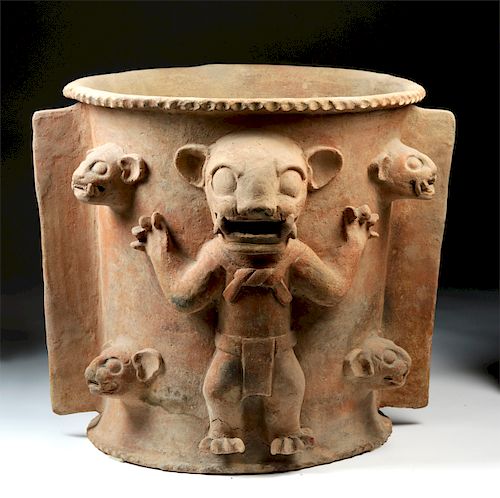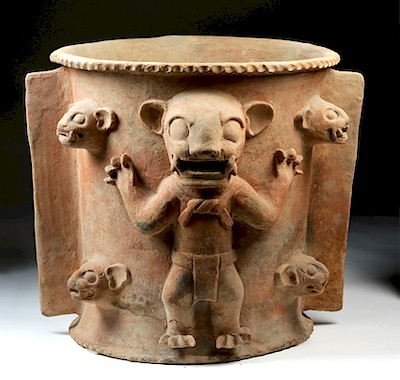Enormous Mayan Pottery Cache Vessel w/ 5 Jaguars, TL'd
Lot 110b
About Seller
Artemis Fine Arts
686 S Taylor Ave, Ste 106
Louisville, CO 80027
United States
Selling antiquities, ancient and ethnographic art online since 1993, Artemis Gallery specializes in Classical Antiquities (Egyptian, Greek, Roman, Near Eastern), Asian, Pre-Columbian, African / Tribal / Oceanographic art. Our extensive inventory includes pottery, stone, metal, wood, glass and textil...Read more
Estimate:
$10,000 - $15,000
Absentee vs Live bid
Two ways to bid:
- Leave a max absentee bid and the platform will bid on your behalf up to your maximum bid during the live auction.
- Bid live during the auction and your bids will be submitted real-time to the auctioneer.
Bid Increments
| Price | Bid Increment |
|---|---|
| $0 | $25 |
| $300 | $50 |
| $1,000 | $100 |
| $2,000 | $250 |
| $5,000 | $500 |
| $10,000 | $1,000 |
| $20,000 | $2,500 |
| $50,000 | $5,000 |
| $100,000 | $10,000 |
| $200,000 | $20,000 |
About Auction
By Artemis Fine Arts
Dec 6, 2018
Set Reminder
2018-12-06 10:00:00
2018-12-06 10:00:00
America/New_York
Bidsquare
Bidsquare : DAY 2 : Pre-Columbian, Ethnographic & Fine Art
https://www.bidsquare.com/auctions/artemis-gallery/day-2-pre-columbian-ethnographic-fine-art-3699
Day 2 of an important 2-dy auction featuring ancient and ethnographic art from around the world. Today's sale will feature Pre-Columbian, Native American, African / Tribal, Ethnographic, Spanish Colonial, Fine Art, much more. Artemis Fine Arts info@artemisfinearts.com
Day 2 of an important 2-dy auction featuring ancient and ethnographic art from around the world. Today's sale will feature Pre-Columbian, Native American, African / Tribal, Ethnographic, Spanish Colonial, Fine Art, much more. Artemis Fine Arts info@artemisfinearts.com
- Lot Description
Pre-Columbian, Mayan Territories, Guatemala, El Quiche, Mayan, Classic Period, ca. 250 to 900 CE. A fascinating and exceedingly rare cylindrical vessel, made for holding a cache, featuring a quartet of stylized jaguar heads flanking the upper and lower corners of a well-defined anthropomorphic jaguar. The central feline is presented in high relief and stands upon delineated legs with clawed feet, has a slender body covered with a simple loincloth, displays the twisted cords of a cape across the chest, and poses its bent arms in a defensive manner with outward-pointing claws. Impressed circular eyes, cupped ears, a broad snout, a gaping, fang-filled mouth, and a rounded pate constitute the expressive countenances of both the figure and the surrounding jaguar heads. A pair of tall, rectangular panels delineate the obverse and reverse of the vessel and rest between the two flared, scalloped rims. Size: 21.375" W x 18.125" H (54.3 cm x 46 cm).
Unlike many other ancient civilizations, the Mayans did not have cemeteries or necropolises; instead, they buried both human remains and ritual caches of pottery filled with offerings, jade, beads, and other precious items throughout their lived-in landscape, especially as part of their architecture. These vessels seem to have been "earth offerings" which scholars believe may have been used as dedications for newly built construction, markers for the end of use of a building, or some kind of renewal ceremony relating to the broader concept of Mayan cosmology: the cycle of planting, harvest, and rebirth. Caches have been found in floors, in the fill of buildings, or set into walls. Vessels like this one seem to have been symbolic of houses or structures to the Maya, meaning that they served as symbolic offerings of the buildings in which they were buried, able to be filled with offerings of food or drink, sanctifying the construction. This is a particularly nice example, as many vessels seemingly made only to be cached are of thin construction, because they were never meant for heavy use.
Known as the "king of beasts" in the Pre-Columbian world and infamous for possessing high speed and massive strength, the jaguar was believed to dominate nature and inspire respect and awe throughout the ancient Americas. Jaguars were associated with strength and leadership, whether regarding spirituality or martial skill. Warriors, rulers, hunters, and shamans alike associated themselves with this King of Beasts, the largest and most powerful feline in the New World whom they viewed as their spirit companion and protector. In addition, scholars believe that the jaguar is associated with fertility and vegetation by the Maya; note that the so-called waterlily jaguar is depicted with waterlilies sprouting from its head connoting this fertility. According to a dramatic narrative in the Popol Vuh, the protective hero twin Xbalanque, possessing a zoomorphic phenotype with jaguar skin, fought the monster macaw Vucub Caquix with his twin Hunahpu, and the pair defeated him via trickery.
Acquired by current owners and appraised by Ronald W. Dammann, A.S.A. at Stendahl Galleries, Hollywood, California, USA in 1982.
This piece has been tested using thermoluminescence (TL) analysis and has been found to be ancient and of the period stated. A full report will accompany purchase.
Provenance: private Southern California, USA collection, acquired in 1982 from Stendahl Galleries, Hollywood, California, USA in 1982; appraised by Ronald W. Dammann, A.S.A. at Stendahl Galleries in 1982.
All items legal to buy/sell under U.S. Statute covering cultural patrimony Code 2600, CHAPTER 14, and are guaranteed to be as described or your money back.
A Certificate of Authenticity will accompany all winning bids.
We ship worldwide and handle all shipping in-house for your convenience.
#140957Original lid missing. Vessel repaired from multiple large pieces with some resurfacing and light overpainting along break lines. Small nicks and losses to areas of both rims, full figure, body, and jaguar heads, minor abrasions across most surfaces, and light encrustations. Nice earthen deposits throughout. Two probe holes: one beneath exterior of upper rim, and one atop lower exterior rim.Condition
- Shipping Info
-
All shipping is handled in-house for your convenience. Your invoice from Artemis Gallery will include shipping calculation instructions. If in doubt, please inquire BEFORE bidding for estimated shipping costs for individual items.
-
- Buyer's Premium



 EUR
EUR CAD
CAD AUD
AUD GBP
GBP MXN
MXN HKD
HKD CNY
CNY MYR
MYR SEK
SEK SGD
SGD CHF
CHF THB
THB














